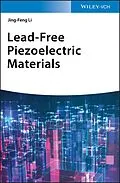Provides in-depth knowledge on lead-free piezoelectrics - for state-of-the-art, environmentally friendly electrical and electronic devices!
Lead zirconate titanate ceramics have been market-dominating due to their excellent properties and flexibility in terms of compositional modifications. Driven by the Restriction of Hazardous Substances Directive, there is a growing concern on the toxicity of lead. Therefore, numerous research efforts were devoted to lead-free piezoelectrics from the beginning of this century. Great progress has been made in the development of high-performance lead-free piezoelectric ceramics which are already used, e.g., for power electronics applications.
Lead-Free Piezoelectric Materials provides an in-depth overview of principles, material systems, and applications of lead-free piezoelectric materials. It starts with the fundamentals of piezoelectricity and lead-free piezoelectrics. Then it discusses four representative lead-free piezoelectric material systems from background introduction to crystal structures and properties. Finally, it presents several applications of lead-free piezoelectrics including piezoelectric actuators, and transducers. The challenges for promoting applications will also be discussed.
- Highly attractive: Lead-free piezoelectrics address the growing concerns on exclusion of hazardous substances used in electrical and electronic devices in order to protect human health and the environment
- Thorough overview: Covers fundamentals, different classes of materials, processing and applications
- Unique: discusses fundamentals and recent advancements in the field of lead-free piezoelectrics
Lead-Free Piezoelectric Materials is of high interest for material scientists, electrical and chemical engineers, solid state chemists and physicists in academia and industry.
Autorentext
Jing-Feng Li is Distinguished Professor in the School of Materials Science and Engineering at Tsinghua University, China. He obtained his PhD degree from Tohoku University, Japan. His research focuses on piezoelectric, thermoelectric materials and devices. He has published two Chinese books and more than 490 peer-reviewed papers and holds 34 patents. He received several awards, including the young researcher award from the Japan Institute of Metals, an outstanding young scientist grant from Natural Science Foundation of China and the Changjiang professorship from The Ministry of Education of China.
Inhalt
CHAPTER 1 FUNDAMENTALS OF PIEZOELECTRICITY
Piezoelectric effects and related equations
Ferroelectric properties and its contribution to piezoelectricity
Description of piezoelectric parameters
Issues for measuring piezoelectric properties
CHAPTER 2 INTRODUCTION TO LEAD-FREE PIEZOELECTRICS
Background of lead-free piezoelectric research
General classification of lead-free piezoelectrics
General information about the research progress of lead-free piezoelectrics
CHAPTER 3 (K, Na)NbO3 SYSTEM
Introduction
Phase structure, sintering process, property enhancement
Difference from PZT
CHAPTER 4 (Bi1/2Na1/2)TiO3 SYSTEM
Extensive research on phase diagram of (Bi1/2Na1/2)TiO3-BaTiO3 system with a PZT-like MPB
High converse piezoelectricity and electric-field-induced deformation
Relaxor behavior
CHAPTER 5 BaTiO3 SYSTEM
Introduction
Outstandingly high d33 in BaTiO3-CaZrO3
CHAPTER 6 BiFeO3 SYSTEM
Introduction
High Curie temperature and potential as lead-free piezoelectrics
Processing difficulty
CHAPTER 7 Bi-LAYER STRUCTURED HIGH Tc SYSTEM
Detailed description of structures
Extremely high Curie temperature
Texturing process
CHAPTER 8 APPLICATIONS
Representative examples of disclosure applications using lead-free piezoelectrics
Outlooks
